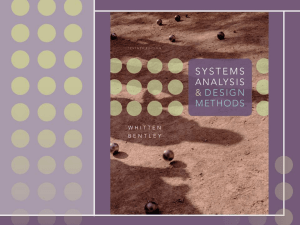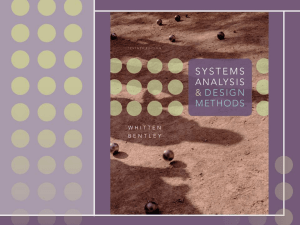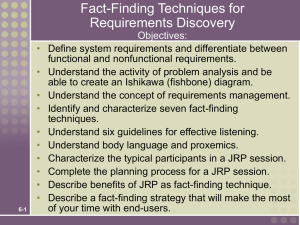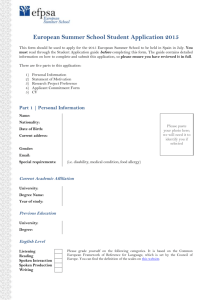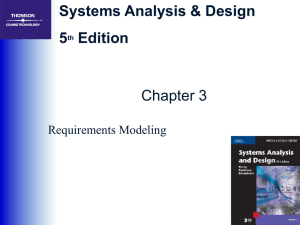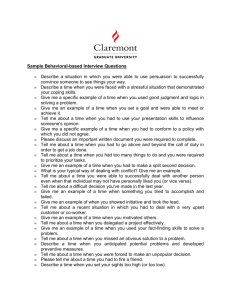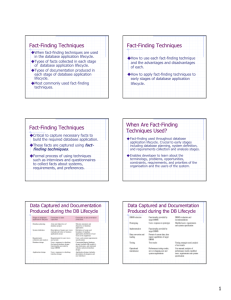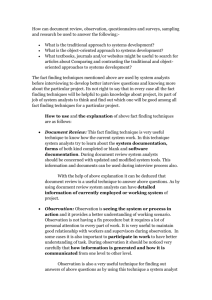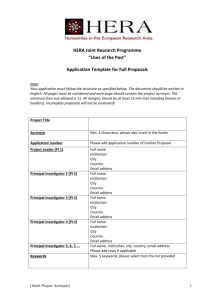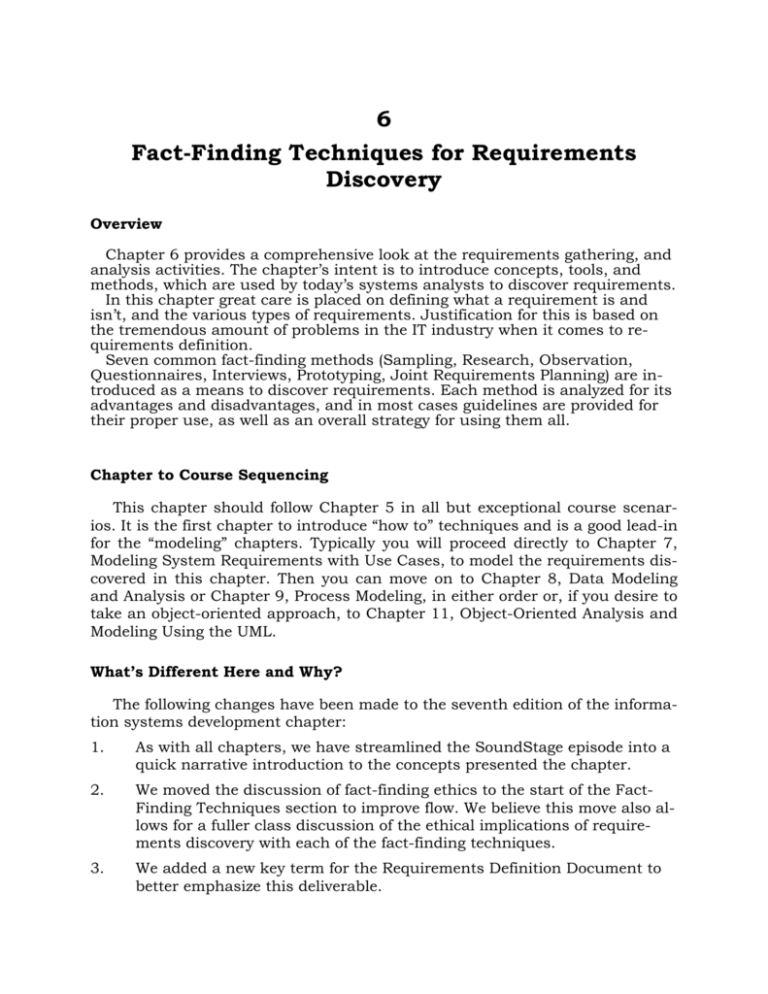
6
Fact-Finding Techniques for Requirements
Discovery
Overview
Chapter 6 provides a comprehensive look at the requirements gathering, and
analysis activities. The chapter’s intent is to introduce concepts, tools, and
methods, which are used by today’s systems analysts to discover requirements.
In this chapter great care is placed on defining what a requirement is and
isn’t, and the various types of requirements. Justification for this is based on
the tremendous amount of problems in the IT industry when it comes to requirements definition.
Seven common fact-finding methods (Sampling, Research, Observation,
Questionnaires, Interviews, Prototyping, Joint Requirements Planning) are introduced as a means to discover requirements. Each method is analyzed for its
advantages and disadvantages, and in most cases guidelines are provided for
their proper use, as well as an overall strategy for using them all.
Chapter to Course Sequencing
This chapter should follow Chapter 5 in all but exceptional course scenarios. It is the first chapter to introduce “how to” techniques and is a good lead-in
for the “modeling” chapters. Typically you will proceed directly to Chapter 7,
Modeling System Requirements with Use Cases, to model the requirements discovered in this chapter. Then you can move on to Chapter 8, Data Modeling
and Analysis or Chapter 9, Process Modeling, in either order or, if you desire to
take an object-oriented approach, to Chapter 11, Object-Oriented Analysis and
Modeling Using the UML.
What’s Different Here and Why?
The following changes have been made to the seventh edition of the information systems development chapter:
1.
As with all chapters, we have streamlined the SoundStage episode into a
quick narrative introduction to the concepts presented the chapter.
2.
We moved the discussion of fact-finding ethics to the start of the FactFinding Techniques section to improve flow. We believe this move also allows for a fuller class discussion of the ethical implications of requirements discovery with each of the fact-finding techniques.
3.
We added a new key term for the Requirements Definition Document to
better emphasize this deliverable.
6-2
Chapter Six
4.
We added a list of what analysts can clean from existing documentation.
5.
We expanded the discussion of how to conduct the interview, including
tips for dressing to match the interviewee and how to ask "what if" questions.
Lesson Planning Notes for Slides
The following instructor notes, keyed to slide images from the PowerPoint
repository, are intended to help instructors integrate the slides into their individual lesson plans for this chapter.
Slide 1
Chapter 6
Fact-Finding
Techniques for
Requirements
Discovery
McGraw-Hill/Irwin
Copyright © 2007 by The McGraw-Hill Companies, Inc. All rights reserved.
slide appearance after initial mouse click
in slide show mode
Slide 2
Objectives
6-2
• Define system requirements and differentiate between
functional and nonfunctional requirements.
• Understand the activity of problem analysis and be
able to create an Ishikawa (fishbone) diagram.
• Understand the concept of requirements management.
• Identify and characterize seven fact-finding
techniques.
• Understand six guidelines for effective listening.
• Understand body language and proxemics.
• Characterize the typical participants in a JRP session.
• Complete the planning process for a JRP session.
• Describe benefits of JRP as fact-finding technique.
• Describe a fact-finding strategy that will make the most
of your time with end-users.
Copyright © 2007 The McGraw-Hill Companies. All Rights reserved.
This repository of slides is intended to support the
named chapter. The slide repository should be
used as follows:
Copy the file to a unique name for your course
and unit.
Edit the file by deleting those slides you don’t
want to cover, editing other slides as appropriate
to your course, and adding slides as desired.
Print the slides to produce transparency masters
or print directly to film or present the slides using
a computer image projector.
Most slides include instructor notes. In recent
versions of PowerPoint, notes by default display
in a window under the slide. The instructor notes
are also reprinted below.
Chapter 6 objectives.
Fact-Finding Techniques for Requirements Discovery
6-3
Teaching Notes
This slide shows the how this chapter's content
fits with the building blocks framework used
throughout the textbook. Requirements Discovery
is used throughout all the early phases; touches
on knowledge, processes, and communications;
and involves system owners, system users, and
systems analysts.
Slide 3
6-3
Slide 4
Introduction to Requirements
Discovery
Requirements discovery – the process
and techniques used by systems analysts
to identify or extract system problems and
solution requirements from the user
community.
Teaching Notes
This chapter focuses on the techniques and activities for eliciting system requirements as well
as how to properly validate and document requirements. The authors have placed an emphasis on this chapter because recent studies have
shown that as many as 80% of all system development failures can be traced back to problems
with requirements.
System requirement – something that
the information system must do or a
property that it must have. Also called a
business requirement.
6-4
Slide 5
Functional vs. Nonfunctional
Requirements
Functional requirement - something the
information system must do
Conversion Notes
This slide is new in the seventh edition. The difference between functional and nonfunctional
requirements is also covered in Chapter 5 but is
repeated here because some instructors skip
Chapter 5.
Nonfunctional requirement - a property
or quality the system must have
• Performance
• Security
• Costs
6-5
Copyright © 2007 The McGraw-Hill Companies. All Rights reserved.
6-4
Chapter Six
Slide 6
Results of Incorrect
Requirements
6-6
Slide 7
• The system may cost more than projected.
• The system may be delivered later than
promised.
• The system may not meet the users’
expectations and they may not to use it.
• Once in production, costs of maintaining and
enhancing system may be excessively high.
• The system may be unreliable and prone to
errors and downtime.
• Reputation of IT staff is tarnished as failure will
be perceived as a mistake by the team.
Relative Cost to Fix an Error
Teaching Notes
This slide (and the next) emphasize the importance of spending time in defining system requirements.
Teaching Notes
Table based on work by Barry W. Boehm, a
noted expert in information technology economics. Based on these findings, an erroneous requirement that goes undetected and unfixed until
the operation phase may cost 1,000 times more
than if it were detected and fixed in the requirements phase!
6-7
Slide 8
Criteria for System
Requirements
6-8
• Consistent – not conflicting or ambiguous.
• Complete – describe all possible system
inputs and responses.
• Feasible – can be satisfied based on the
available resources and constraints.
• Required – truly needed and fulfill the purpose
of the system.
• Accurate – stated correctly.
• Traceable – directly map to functions and
features of system.
• Verifiable – defined so can be demonstrated
during testing.
Copyright © 2007 The McGraw-Hill Companies. All Rights reserved.
Teaching Notes
Requirements rarely initially emerge in a form
that meets these criteria. Requirements discovery
is an iterative process that involves refining and
revising the requirements until they are correct.
Fact-Finding Techniques for Requirements Discovery
Slide 9
Process of Requirements
Discovery
6-5
Teaching notes
The process of requirements discovery consists
of four activities.
• Problem discovery and analysis
• Requirements discovery
• Documenting and analyzing
requirements
• Requirements management
6-9
Slide 10
Ishikawa Diagram
• Graphical tool used to identify, explore, and depict
problems and the causes and effects of those
problems. It is often referred to as a cause-and-effect
diagram or a fishbone diagram.
• Problem at right (fish head)
• Possible causes drawn as "bones" off main backbone
• Brainstorm for 3-6 main categories of possible causes
6-10
Slide 11
Requirements Discovery
• Given an understand of problems, the systems
analyst can start to define requirements.
Fact-finding – the formal process of using
research, meetings, interviews, questionnaires,
sampling, and other techniques to collect
information about system problems,
requirements, and preferences. It is also called
information gathering or data collection.
Teaching Notes
Explain concept to students.
The name of the problem goes at the right of the
diagram (the fish’s head).
The possible causes of the problem are drawn as
bones off the main backbone, grouped by 4 Ms
(Materials, Machines, Manpower [People], and
Methods) plus other categories that are appropriate to the problem at hand.
The team can then determine the most likely
cause or causes.
Try to do another example during lecture based
on a well-known problem that most students experience, such as college class registration.
Teaching Notes
Stress that fact-finding is a technique that is used
across the entire development cycle but it is extremely critical in the requirements analysis
phase.
Be sure to discuss the role of ethics during the
fact-finding activity.
6-11
Copyright © 2007 The McGraw-Hill Companies. All Rights reserved.
6-6
Chapter Six
Slide 12
Documenting and Analyzing
Requirements
No additional notes.
• Documenting the draft requirements
• Use cases
• Decision tables
• Requirements tables
• Analyzing requirements to resolve problems
•
•
•
•
•
Missing requirements
Conflicting requirements
Infeasible requirements
Overlapping requirements
Ambiguous requirements
• Formalizing requirements
6-12
Slide 13
• Requirements definition document
• Communicated to stakeholders or steering body
Requirements Definition
Document
Conversion Notes
This is a new slide in the seventh edition
Requirements Definition Document – A formal
document that communicates the requirements
of a proposed system to key stakeholders and
serves as a contract for the systems project.
• Synonyms
•
•
•
•
Requirements definition report
Requirements statement
Requirements specification
Functional specifications
6-13
Slide 14
Sample Requirements
Definition Report Outline
6-14
Teaching Notes
There is no standard name or format for this
document. In fact, many organizations use different names such as requirements statement, requirements specification, requirements definition,
functional specification, etc., and the format is
usually tailored to that organization’s needs.
For those companies that provide information
systems and software to the U.S. government,
the government requires that they use the format
and naming conventions specified in their published standards document MIL-STD-498[1].
Many organizations have created their own standards adapted from MIL-STD-498 because of its
thoroughness and because many people are
already familiar with it.
In this book we will use the term requirements
definition document .
[1] MIL-STD-498 is a standard that merges DODSTD-2167A and DOD-STD-7935A to define a set
of activities and documentation suitable for the
development of both weapon systems and automated information systems.
Copyright © 2007 The McGraw-Hill Companies. All Rights reserved.
Fact-Finding Techniques for Requirements Discovery
Slide 15
Requirements Management
Requirements management - the process of
managing change to the requirements.
• Over the lifetime of the project it is very common for
new requirements to emerge and existing
requirements to change.
• Studies have shown that over the life of a project as
much as 50 percent or more of the requirements will
change before the system is put into production.
6-15
Slide 16
Fact-Finding Ethics
• Fact-Finding often brings systems analysts into contact
with sensitive information.
6-7
Teaching Notes
You might want to have the class brainstorm on
some of the problems that can be caused by
adding requirements later. These would include
conflict with existing requirements, major
changes to data structures that impacts other
parts of the design, and schedule and budget
concerns.
Requirements management encompasses the
policies, procedures, and processes that govern
how a change to a requirement is handled. In
other words, it specifies how a change request
should be submitted, how it is analyzed for impact to scope, schedule, and cost, how it’s approved or rejected, and how the change is implemented if approved.
Teaching Notes
The instructor may want to share personal experiences about being in contact with sensitive
information.
• Company plans
• Employee salaries or medical history
• Customer credit card, social security, or other information
• Ethical behavior
• Systems analysts must not misuse information.
• Systems analysts must protect information from people who
would misuse it.
• Otherwise
6-16
Slide 17
• Systems analyst loses respect, credibility, and confidence of
users and management, impairing ability to do job
• Organization and systems analyst could have legal liability
• Systems analyst could lose job
Seven Fact-Finding Methods
Teaching Notes
Each will each be discussed later in the chapter.
• Sampling of existing documentation,
forms, and databases.
• Research and site visits.
• Observation of the work environment.
• Questionnaires.
• Interviews.
• Prototyping.
• Joint requirements planning (JRP).
6-17
Copyright © 2007 The McGraw-Hill Companies. All Rights reserved.
6-8
Chapter Six
Slide 18
Sampling Existing
Documentation, Forms, & Files
No additional notes.
Sampling –process of collecting a representative
sample of documents, forms, and records.
6-18
Slide 19
• Organization chart
• Memos and other documents that describe the
problem
• Standard operating procedures for current system
• Completed forms
• Manual and computerized screens and reports
• Samples of databases
• Flowcharts and other system documentation
• And more
Things to be Gleaned from
Documents
• Symptoms and causes of problems
• Persons in organization who have
understanding of problem
• Business functions that support the
present system
• Type of data to be collected and reported
by the system
• Questions that need to be covered in
interviews
Conversion Notes
This is a new slide for the seventh edition
Teaching Notes
The instructor could bring in memos, organization
charts, etc. (subject to fact-finding ethics) to
demonstrate how these kinds of information could
be gleaned from those documents.
6-19
Slide 20
Why to Sample Completed
Rather than Blank Forms
• Can determine type of data going into each blank
• Can determine size of data going into each blank
• Can determine
which blanks
are not used
or not always
used
• Can see data
relationships
6-20
Copyright © 2007 The McGraw-Hill Companies. All Rights reserved.
Teaching Notes
As an class exercise you can walk through this
form from an old case study to see what the data
tells you. Depending on the classes prior to familiarity with database concepts, this form can
reveal:
That computer names are alphanumeric
That assigned to appears to be a 3-character
initial
That Ext is a 4-digit extension number and not a
full phone number
That the Problem Description is a large text area
that sometimes contains only a few words.
That there is a one-to-many relationship between
Service Requests and the work done on them.
That Work Comments is a large text area.
Fact-Finding Techniques for Requirements Discovery
Slide 21
6-9
Determining Sample Size for
Forms
• Sample Size = 0.25 x (Certainty factor/Acceptable error) 2
• Sample Size = 0.25(1.645/0.10) 2 = 68
• Sample Size =0.10(1 – 0.10)(1.645/0.10)2 = 25
Or if analyst
knows 1 in 10
varies from norm.
Certainty factor from
certainty table. 10%
acceptable error.
Teaching Notes
Two versions of the sampling formula are provided in the textbook. The first uses a heuristic
(.25) to calculate the sample size and the second
replaces the (.25) with p(1-p) to reflect the knowledge of errors in the sample population. Review
each with students and calculate various sample
sizes using different levels of certainty.
6-21
Slide 22
Sampling Techniques
Randomization – a sampling technique
characterized by having no predetermined
pattern or plan for selecting sample data.
Stratification – a systematic sampling
technique that attempts to reduce the
variance of the estimates by spreading out the
sampling—for example, choosing documents
or records by formula—and by avoiding very
high or low estimates.
Teaching Notes
For randomization you just randomly choose the
number of sample items based on the sample
size calculated.
For computerized files, stratification sampling can
be executed by writing a simple program. For
instance, suppose invoices were stored in a database that had a volume of approximately
250,000. If the required sample size was 25, a
program could be written that prints every
10,000th record (=250,000/25).
6-22
Slide 23
Observation
Observation – a fact-finding technique wherein
the systems analyst either participates in or
watches a person perform activities to learn
about the system.
Advantages?
Disadvantages?
Work sampling - a fact-finding technique that
involves a large number of observations taken
at random intervals.
Teaching Notes
This technique is often used when the validity of
data collected through other methods is in question or when the complexity of certain aspects of
the system prevents a clear explanation by the
end-users.
Have students review The Railroad Paradox by
Gerald M. Weinberg. Discuss the moral of the
story.
Have students provide advantages and disadvantages of observation.
6-23
Copyright © 2007 The McGraw-Hill Companies. All Rights reserved.
6-10
Chapter Six
Conversion Notes
This is a new slide in the seventh edition.
Slide 24
Observation
Advantages
Disadvantages
• Data gathered can be
very reliable
• Can see exactly what is
being done in complex
tasks
• Relatively inexpensive
compared with other
techniques
• Can do work
measurements
• People may perform
differently when being
observed
• Work observed may
not be representative of
normal conditions
• Timing can be
inconvenient
• Interruptions
• Some tasks not always
performed the same
way
• May observe wrong
way of doing things
6-24
Slide 25
Observation Guidelines
6-25
Slide 26
No additional notes.
• Determine the who, what, where, when, why, and
how of the observation.
• Obtain permission from appropriate supervisors.
• Inform those who will be observed of the purpose
of the observation.
• Keep a low profile.
• Take notes.
• Review observation notes with appropriate
individuals.
• Don't interrupt the individuals at work.
• Don't focus heavily on trivial activities.
• Don't make assumptions.
Questionnaires
Questionnaire – a special-purpose document that
allows the analyst to collect information and opinions
from respondents.
Free-format questionnaire – a questionnaire designed
to offer the respondent greater latitude in the answer. A
question is asked, and the respondent records the
answer in the space provided after the question.
Fixed-format questionnaire – a questionnaire
containing questions that require selecting an answer
from predefined available responses.
6-26
Copyright © 2007 The McGraw-Hill Companies. All Rights reserved.
Teaching Notes
Have students provide advantages and disadvantages of observation.
Have students provide examples of both freeformat and fixed-format questions. The difference
between the two is essentially the difference
between a multiple-choice and essay exam.
Fact-Finding Techniques for Requirements Discovery
Conversion Notes
This is a new slide in the seventh edition.
Slide 27
Questionnaires
6-27
Slide 28
Advantages
Disadvantages
• Often can be answered
quickly
• People can complete at
their convenience
• Relatively inexpensive
way to gather data from
a large number
• Allow for anonymity
• Responses can be
tabulated quickly
• Return rate is often low
• No guarantee that an
individual will answer
all questions
• No opportunity to
reword or explain
misunderstood
questions
• Cannot observe body
language
• Difficult to prepare
Types of Fixed-Format
Questions
• Multiple-choice questions
• Rating questions
• Ranking questions
Rank the following transactions according to the amount of time you spend
processing them.
___ % new customer orders
The implementation of quality discounts would
___ % order cancellations
cause an increase in customer orders.
___ % order modifications
___ Strongly agree
___ % payments
___ Agree
___ No opinion
Is the current accounts receivable
___ Disagree
report that you receive useful?
___ Strongly disagree ___ Yes
6-28
Slide 29
6-11
___ No
Developing a Questionnaire
Teaching Notes
Ask students to classify each of the sample questions.
For multiple-choice questions, the respondent
is given several answers. The respondent should
be told if more than one answer might be selected.
For rating questions, the respondent is given a
statement and asked to use supplied responses
to state an opinion. To prevent built-in bias, there
should be an equal number of positive and negative ratings.
For ranking questions, the respondent is given
several possible answers, which are to be ranked
in order of preference or experience.
No additional notes.
1. Determine what facts and opinions must be
collected and from whom you should get them.
2. Based on the facts and opinions sought,
determine whether free- or fixed-format
questions will produce the best answers.
3. Write the questions.
4. Test the questions on a small sample of
respondents.
5. Duplicate and distribute the questionnaire.
6-29
Copyright © 2007 The McGraw-Hill Companies. All Rights reserved.
6-12
Chapter Six
Slide 30
Teaching Notes
Have students provide advantages and disadvantages of interviews.
Interviews
Interview - a fact-finding technique whereby the
systems analysts collect information from
individuals through face-to-face interaction.
•
•
•
•
•
•
•
Find facts
Verify facts
Clarify facts
Generate enthusiasm
Get the end-user involved
Identify requirements
Solicit ideas and opinions
The personal interview
is generally recognized
as the most important
and most often used
fact-finding technique.
6-30
Slide 31
Types of Interviews and
Questions
Unstructured interview –conducted with only a general
goal or subject in mind and with few, if any, specific
questions. The interviewer counts on the interviewee to
provide a framework and direct the conversation.
Structured interview –interviewer has a specific set of
questions to ask of the interviewee.
Teaching Notes
An unstructured interview frequently gets off
track, and the analyst must be prepared to redirect the interview back to the main goal or subject. For this reason, unstructured interviews don't
usually work well for systems analysis and design.
Have students provide examples of open-ended
and closed-ended questions.
Open-ended question – question that allows the
interviewee to respond in any way.
6-31
Closed-ended question – a question that restricts
answers to either specific choices or short, direct
responses.
Conversion Notes
This slide is new in the seventh edition.
Slide 32
Interviews
Advantages
• Give analyst opportunity
to motivate interviewee
to respond freely and
openly
• Allow analyst to probe
for more feedback
• Permit analyst to adapt
or reword questions for
each individual
• Can observe nonverbal
communication
Disadvantages
• Time-consuming
• Success highly
dependent on analyst's
human relations skills
• May be impractical due
to location of
interviewees
6-32
Copyright © 2007 The McGraw-Hill Companies. All Rights reserved.
Fact-Finding Techniques for Requirements Discovery
Slide 33
6-13
No additional notes.
Procedure to Conduct an
Interview
1. Select Interviewees
• End users
• Learn about individual prior to the interview
2. Prepare for the Interview
• interview guide
3. Conduct the Interview
• Summarize the problem
• Offer an incentive for participation
• Ask the interviewee for assistance
4. Follow Up on the Interview
• Memo that summarizes the interview
6-33
Slide 34
No additional notes.
Sample Interview Guide
6-34
Slide 35
(continued)
Sample Interview Guide
(concluded)
No additional notes.
6-35
Copyright © 2007 The McGraw-Hill Companies. All Rights reserved.
6-14
Chapter Six
Slide 36
Prepare for the Interview
Teaching Notes
Have students provide examples of loaded, leading, and biased questions.
• Types of Questions to Avoid
• Loaded questions
• Leading questions
• Biased questions
• Interview Question Guidelines
• Use clear and concise language.
• Don’t include your opinion as part of the question.
• Avoid long or complex questions.
• Avoid threatening questions.
• Don’t use “you” when you mean a group of people.
6-36
Slide 37
Conversion Notes
This is a new slide in the seventh edition.
Conduct the Interview
• Dress to match interviewee
• Arrive on time
• Or early if need to confirm room setup
• Open interview by thanking interviewee
• State purpose and length of interview and how
data will be used
• Monitor the time
• Ask follow-up questions
• Probe until you understand
• Ask about exception conditions ("what if...")
6-37
Slide 38
Interviewing Do’s and Don’ts
Do
•
•
•
•
•
•
6-38
•
•
•
•
Dress appropriately
Be courteous
Listen carefully
Maintain control of the
interview
Probe
Observe mannerisms and
nonverbal communication
Be patient
Keep interviewee at ease
Maintain self-control
Finish on time
Don't
• Assume an answer is
finished or leading
nowhere
• Reveal verbal and
nonverbal clues
• Use jargon
• Reveal personal biases
• Talk more than listen
• Assume anything about
the topic or the interviewee
• Tape record (take notes
instead)
Copyright © 2007 The McGraw-Hill Companies. All Rights reserved.
Teaching Notes
Discuss with the students each of the items and
the reasons for their classifications.
Fact-Finding Techniques for Requirements Discovery
Slide 39
Body Language and Proxemics
Body language – the nonverbal information we
communicate.
• Facial disclosure
• Eye contact
• Posture
Proxemics – the relationship between people
and the space around them.
•
•
•
•
Intimate zone—closer than 1.5 feet
Personal zone—from 1.5 feet to 4 feet
Social zone—from 4 feet to 12 feet
Public zone—beyond 12 feet
6-39
Slide 40
Discovery Prototyping
Discovery prototyping – the act of
building a small-scale, representative or
working model of the users’ requirements
in order to discover or verify those
requirements.
6-15
Teaching Notes
Research studies have determined a startling fact
— of a person's total feelings, only 7 percent are
communicated verbally (in words), 38 percent are
communicated by the tone of voice used, and 55
percent of those feelings are communicated by
facial and body expressions.
Certain types of communications take place only
in some of these zones. For example, an analyst
conducts most interviews with system users in
the personal zone. But the analyst may need to
move back to the social zone if the user displays
any signs (body language) of being uncomfortable. Sometimes increasing eye contact can
make up for a long distance that can't be
changed. Many people use the fringes of the
social zone as a “respect” distance.
Teaching Notes
Discovery prototyping is frequently applied to
systems development projects, especially in
those cases where the development team is having problems defining the system requirements.
The philosophy is that the users will recognize
their requirements when they see them.
Have students provide advantages and disadvantages of discovery prototyping.
6-40
Slide 41
Discovery Prototyping
6-41
Advantages
Disadvantages
• Can experiment to
develop understanding
of how system might
work
• Aids in determining
feasibility and
usefulness of system
before development
• Serves as training
mechanism
• Aids in building test
plans and scenarios
• May minimize time spent
on fact-finding
• Developers may need to
be trained in prototyping
• Users may develop
unrealistic expectations
• Could extend
development schedule
Conversion Notes
This is a new slide in the seventh edition.
Copyright © 2007 The McGraw-Hill Companies. All Rights reserved.
6-16
Chapter Six
Slide 42
Joint Requirements Planning
Joint requirements planning (JRP) – a
process whereby highly structured group
meetings are conducted for the purpose of
analyzing problems and defining
requirements.
Teaching Notes
JRP (and JAD) techniques are becoming increasingly common in systems planning and systems
analysis to obtain group consensus on problems,
objectives, and requirements.
• JRP is a subset of a more comprehensive
joint application development or JAD
technique that encompasses the entire
systems development process.
6-42
Slide 43
JRP Participants
•
•
•
•
•
Teaching Notes
Discuss the role of each. Be sure to focus on the
skills needed to be a successful JRP facilitator.
Sponsor
Facilitator
Users and Managers
Scribes
IT Staff
6-43
Slide 44
Steps to Plan a JRP Session
1. Selecting a location
• Away from workplace when possible
• Requires several rooms
• Equipped with tables, chairs, whiteboard, overhead
projectors
• Needed computer equipment
2. Selecting the participants
• Each needs release from regular duties
3. Preparing the agenda
• Briefing documentation
• Agenda distributed before each session
6-44
Copyright © 2007 The McGraw-Hill Companies. All Rights reserved.
Teaching Notes
Discuss why the JRP session location should be
held off-site.
Discuss why many companies opt to hire qualified JRP facilitators from outside the organization.
Fact-Finding Techniques for Requirements Discovery
Slide 45
6-17
Typical Room Layout for JRP
session
Teaching Notes
Discuss the seating arrangement of the participants as well as where the equipment is located.
Also solicit the opinions of students in the way of
providing refreshments. Do they think it is necessary?
Guidelines for Conducting
a JRP Session
No additional notes.
6-45
Slide 46
•
•
•
•
•
•
•
•
Do not unreasonably deviate from the agenda
Stay on schedule
Ensure that the scribe is able to take notes
Avoid the use of technical jargon
Apply conflict resolution skills
Allow for ample breaks
Encourage group consensus
Encourage user and management participation without
allowing individuals to dominate the session
• Make sure that attendees abide by the established
ground rules for the session
6-46
Slide 47
Brainstorming
No additional notes.
• Sometimes, one of the goals of a JRP session
is to generate possible ideas to solve a problem.
• Brainstorming is a common approach that is used for
this purpose.
Brainstorming – a technique for generating
ideas by encouraging participants to offer as
many ideas as possible in a short period of time
without any analysis until all the ideas have
been exhausted.
6-47
Copyright © 2007 The McGraw-Hill Companies. All Rights reserved.
6-18
Chapter Six
Slide 48
Brainstorming Guidelines
• Isolate appropriate people in a place that free from
distractions and interruptions.
• Make sure everyone understands purpose of the
meeting.
• Appoint one person to record ideas.
• Remind everyone of brainstorming rules.
• Within a specified time period, team members call out
their ideas as quickly as they can think of them.
• After group has run out of ideas and all ideas have
been recorded, then and only then should ideas be
evaluated.
• Refine, combine, and improve ideas generated earlier.
Teaching Notes
Be sure to discuss the rules of brainstorming:
Be spontaneous. Call out ideas as fast as they
occur.
Absolutely no criticism, analysis, or evaluation of
any kind is permitted while the ideas are being
generated. Any idea may be useful, if only to
spark another idea.
Emphasize quantity of ideas, not necessarily
quality.
6-48
Slide 49
Benefits of JRP
• JRP actively involves users and
management in the development project
(encouraging them to take “ownership” in
the project).
• JRP reduces the amount of time required
to develop systems.
• When JRP incorporates prototyping as a
means for confirming requirements and
obtaining design approvals, the benefits of
prototyping are realized
Teaching Notes
Discuss the reasons why JRP reduces the
amount of time required to develop systems.
Note the differences between calendar time and
person-hours. JRP may require more personhours but reduces calendar time. Ask the students to name situations in which minimizing one
or the other would be more important.
6-49
Slide 44
A Fact-Finding Strategy
1. Learn from existing documents, forms, reports,
and files.
2. If appropriate, observe the system in action.
3. Given all the facts that already collected, design
and distribute questionnaires to clear up things
that aren’t fully understood.
4. Conduct interviews (or group work sessions).
5. (Optional). Build discovery prototypes for any
functional requirements that are not understood
or for requirements that need to be validated.
6. Follow up to verify facts.
6-50
Copyright © 2007 The McGraw-Hill Companies. All Rights reserved.
Teaching Notes
This is one possible strategy, but one that minimizes wasting user time.
An analyst needs an organized method for collecting facts. An inexperienced analyst will frequently jump right into interviews. “Go to the people. That's where the real facts are!'' Wrong! This
attitude fails to recognize an important fact of life:
people must complete their day-to-day jobs! Your
job is not their main responsibility. Your demand
on their time is their time and money lost.
Fact-Finding Techniques for Requirements Discovery
6-19
Answers to End of Chapter Questions and Exercises
Review Questions
1. Requirements discovery is of the utmost importance because we must correctly
identify, analyze, and understand the users’ requirements, and/or
what the users want the system to do, in order to effectively design, construct, and ultimately implement a system to meet their needs.
2. • The system may cost more than projected.
• The system may be delivered later than promised.
• The system may not meet the users’ expectations, and that dissatisfaction may cause them not to use it.
• Once in production, the costs of maintaining and enhancing the system
may be excessively high.
• The system may be unreliable and prone to errors and downtime.
• The reputation of the IT staff on the team is tarnished because any failure, regardless of who is at fault, will be perceived as a mistake by the
team.
3. • Consistent—the requirements are not conflicting or ambiguous.
• Complete—the requirements describe all possible system inputs and responses.
• Feasible—the requirements can be satisfied based on the available resources and constraints.
• Required—the requirements are truly needed and fulfill the purpose of
the system.
• Accurate—the requirements are stated correctly.
• Traceable—the requirements directly map to the functions and features
of the system.
• Verifiable—the requirements are defined so that they can be demonstrated during testing.
4. •
•
•
•
Problem discovery and analysis
Requirements discovery
Documenting and analyzing requirements
Requirements management
5. An Ishikawa diagram is a graphical tool used by developers to identify, explore, and depict problems, and the causes and effects of those problems. It
is often referred to as a cause-and-effect diagram or a fishbone diagram because of its shape.
The basic concept of the Ishikawa diagram is that the name of the problem of interest is entered at the right of the diagram (or the fish’s head) and
Copyright © 2007 The McGraw-Hill Companies. All Rights reserved.
6-20
Chapter Six
the possible causes of the problems are drawn as “bones” off the main
backbone. In general, there are four basic categories of bones: materials,
machines, manpower and methods. As alternative or additional categories,
the categories can include places, procedures, policies and people, or surroundings, suppliers, systems and skills.
6. Fact-finding is the technique commonly used. Fact-finding is the formal
process of using research, meetings, interviews, questionnaires, sampling,
and other techniques to collect information about system problems, requirements, and preferences. It is also called information gathering or data
collection.
Fact finding is a critical part of the requirements analysis phase because
facts are the domain of the business application and its end users. Thus,
the analyst must collect those facts accurately and completely in order to effectively apply the documentation tools and techniques, such as use cases,
data models, process models and object models.
7. During the fact-finding activities, it is not uncommon that some of the requirements may be in conflict with one another because requirements are
gathered from many different sources and perspectives. Thus, the goal of
requirement analysis is to discover and solve the problems with the requirements, and to reach agreement on any modifications to satisfy the
needs of the stakeholders. If we do not do that, problems such as missing
requirements, conflicting requirements, infeasible requirements, overlapping
requirements, and ambiguous requirements may occur.
8. The documents describing the problem of the current system.
Examples: Interoffice memoranda, studies, minutes, suggestion box notes,
customer complaints, reports that document the problem area, Accounting
records, performance reviews, and information system project requests.
a. The documents describing the business functions being studied or designed
Examples:
• The company’s mission statement and strategic plan
• Formal objectives for the organization subunits being studied
• Policy manuals that may place constraints on any proposed system
• Completed forms that represent actual transactions at various points
in the processing cycle.
b. The documents of previous system studies and designs performed by
former system analysts and consultants.
Examples:
• Various types of flowcharts and diagrams
Copyright © 2007 The McGraw-Hill Companies. All Rights reserved.
Fact-Finding Techniques for Requirements Discovery
•
•
•
•
6-21
Project dictionaries and repositories
Design documentation, such as inputs, outputs, and databases
Program documentation
Computer operations manuals and training manuals
9. • People at work may unwittingly perform differently when being observed
because people usually feel uncomfortable being watched.
•
The work being observed may not involve the level of difficulty or volume
normally experienced during that time period.
•
Some system activities may take place at odd times, causing a scheduling inconvenience for the system analyst.
•
The tasks being observed are subject to various types of interruptions.
•
Some tasks may not always be performed in the manner in which they
are observed by the system analyst.
•
If people have been performing tasks in a manner that violates standard
operating procedures, they may temporarily perform their jobs correctly
while you are observing them.
•
To offset these drawbacks, systems analysts can use a technique called
work sampling. It is a fact-finding technique that involves taking a large
number of observations at random intervals. This technique tends to be
less intimidating to the people being observed because the observation
period is not continuous.
10. Free-format questionnaire—a questionnaire designed to offer the respondent greater latitude in the answer. A question is asked, and the respondent records the answer in the space provided after the question.
Fixed-format questionnaire—a questionnaire containing questions that require selecting an answer from predefined available responses.
11. • Approach the session with a positive attitude
• Set the other person at ease
• Let the other person know you are listening
• Ask questions
• Don’t assume anything
• Take notes
12. It is a process whereby highly structured group meetings are conducted for
the purpose of analyzing problems and defining requirements.
Copyright © 2007 The McGraw-Hill Companies. All Rights reserved.
6-22
Chapter Six
13. JRP offers many benefits. Some of these benefits are:
•
JRP actively involves users and management in the development project,
and encourages them to “own” the project.
•
JRP reduces the amount of time required to develop systems. This is
achieved by replacing traditional, time-consuming one-on-one interviewing of each user and manager with group meetings. The group meetings
allow for more easily obtaining consensus among the users and managers, as well as resolving conflicting information and requirements.
•
When JRP incorporates prototyping as a means for confirming requirements and obtaining design approvals, the benefits of prototyping are realized.
14. The JRP facilitator is usually responsible for leading all sessions that are
held for a system project. The facilitator’s role is to plan the JRP session,
conduct the session, and follow through on the results. During the session, the facilitator is responsible for leading the discussion, encouraging
the attendees to actively participate, resolving issue conflicts that may
arise, and ensuring that the goals and objectives of the meeting are fulfilled. The facilitator also needs to establish the ground rules that will be
followed during the meeting and ensure that the participants abide by
these rules. Whether a JRP session is productive and successful or not is
highly dependent on the abilities of the facilitator. .
15. JRP sessions should be conducted away from the company workplace. By
holding JRP session at an off-site location, the attendees can concentrate
on the issues and activities related to the JRP session, and avoid interruptions and distractions that would occur at their regular workplace.
Problems and Exercises
1. The purpose of requirements discovery is straightforward: to identify accurately and completely the requirements needed for the new system to satisfy
its objectives. If this is not done, there is a high probability that at least one
of the following will occur:
a. The project will run over budget
b. The project will take longer than scheduled
c. The system will not meet expectations
d. Once the system is implemented, the ongoing cost of operations may be
higher than projected.
Copyright © 2007 The McGraw-Hill Companies. All Rights reserved.
Fact-Finding Techniques for Requirements Discovery
6-23
e. The system may not be reliable
f. The IT division may lose credibility because business staff will tend to see
any system failure or problems as their fault.
As for fixing any missed requirements if and when they are discovered further downstream in the project, the system owners should know that costs
rise exponentially in each succeeding phase of the project. This means that
for every dollar spent during requirements discovery to fix an error, $3 - $6
will be spent during the design phase, $10 will be spent during the construction phase to fix the same error, $30 - $70 during acceptance testing,
and up to $1000 after the system is implemented.
2. Every requirement must meet each of the following criteria in order to be
considered a correct requirement:
a. Is the requirement clear and consistent?
b. Is the requirement complete, i.e., does it include all inputs and outputs?
c. Is the requirement feasible, i.e., can it done within the identified constraints and available resources?
d. Is the requirement actually required and needed in order to meet the system objectives?
e. Is the requirement accurately stated?
f. Is the requirement traceable, i.e., can the requirement be mapped to specific system functions and features?
g. Is the requirement verifiable, i.e., can the requirement be tested?
3. Inexperienced analysts frequently tend to confuse a symptom with the actual problem. This error can lead to designing a solution that probably will
not address the real problem, or worse, creates a new problem without solving the original problem!
To reduce the risk of this occurring, systems analysts can use an Ishikawa or fishbone diagram to identify the possible causes of the problem.
This is a graphical diagram that roughly resembles the skeleton of a fish.
The perceived problem is shown on the right, then possible causes are
grouped by category off the main “backbone” of the diagram. These categories may be materials, machines, manpower and methods; places, procedures, policies and people; or surrounding, suppliers, systems and skills.
The completed diagram lists all possible causes, and is used by the project
team to brainstorm what are the most likely causes of the problem.
4. Fact-finding that is accurate and complete is important in every stage.
However, accurate and complete fact-finding is particularly important in the
requirements analysis phase. This is because documentation tools and
techniques, such as use cases, data models, process models and object
models, require a solid requirements analysis foundation in order to be effectively applied.
Copyright © 2007 The McGraw-Hill Companies. All Rights reserved.
6-24
Chapter Six
5. During requirements discovery, system analysts generally review and/or
have access to a great deal of documentation regarding the business or organization. There is a good chance that some of this documentation may
include sensitive or confidential information, such as employee salaries or
health information, trade secrets regarding the company’s products or services, proprietary information regarding their business plans and marketing
strategies, etc.
The consequences of inappropriate disclosure of this information,
whether by carelessness or deliberately, can cause the company and/or
employees great damage. Further, the company and/or individuals responsible may be held legally liable for the disclosure.
Therefore, project staff, whether employees or contractors, must do essentially two things: they must handle and store documents in such a
manner as to ensure that security and confidentiality is not breached. Further, they must ensure that they do not use the information for their own
personal gain, or to allow it to be used for the personal gain of anyone else.
6. Common tools and techniques for documenting initial findings include
• Use cases for describing system functions from the perspective of external users using non and which are written in non-technical language
• Requirements tables (or matrices) listing each individual functional requirement
• Decision tables listing the organizations policies, business roles, and criteria for making decisions.
At this point, the systems analyst definitely should not expect the requirements to be complete and correct, and to be skeptical if they appear to be!
Typical problems that occur and which should be found at this point include requirements that are:
• Missing
• Contradictory
• Not feasible
• Confusing or ambiguous
• Do not stand alone or are not discrete, i.e., they overlap with other requirements
The focus at this point should be on reaching stakeholder agreement by reviewing the requirements to determine whether the right system requirements for the project have been identified. This process will reveal if the
above problems exist, which will need to be fixed now to avoid snowballing
further down the development cycle.
Copyright © 2007 The McGraw-Hill Companies. All Rights reserved.
Fact-Finding Techniques for Requirements Discovery
6-25
8. Once the requirements analysis is completed, a requirements definition
document should be drafted. The purpose of the requirements definition
document is to provide a formal and structured vehicle for communicating
the functional requirements to the core stakeholders for their review. Once
this document is finalized, it becomes in effect a contract between the system owners and the developers as to what is to be provided in the new system. Typically, the requirements definition document includes:
• System purpose and scope
• Functional requirements
• Nonfunctional requirements
• Constraints, both developmental and operational
• System interfaces
• Outstanding issues
9. The ‘rule-of-thumb’ formula for determining formula size is:
Sample size = .025 X (Certainty factor/Acceptable error)2
With a certainty factor of 95%, the sample size would be calculated as follows:
SS = 0.25(1.960/0.05)2 = 384
Increasing the number of sales orders per day to 25,000 does not change
the sampling size; it remains the same.
10. Advantages include:
• Very cost-effective method to quickly get uniform information from large
groups of stakeholders
• Stakeholders can respond to most surveys at their convenience and
without spending a great deal of time.
• Stakeholders may be more candid because surveys can be answered
anonymously
• Compilation of the results is generally straightforward and rapid.
Disadvantages include:
• Survey questions may be ambiguous and/or subject to misinterpretation, which can skew the results.
• Stakeholders may skip certain questions, or not respond at all to the
survey
• The systems analyst cannot ask additional questions or observe the respondent’s non-verbal responses, such as body language.
• Writing an effective survey can be very time-consuming.
Copyright © 2007 The McGraw-Hill Companies. All Rights reserved.
6-26
Chapter Six
Fixed format questions might be chosen when questions are straightforward and additional information is not necessary, and/or when you must
be able to compile the results quickly, but have a large number of people to
survey.
Free-format questions might be chosen when it would be useful for respondents to be able to ‘build’ on their answers, or when the questions are
open-ended and compiling the results is not an issue.
A question may allow for both; respondents must answer the fixed format
section, but are also given the opportunity to expand their answer in a freeformat comment section.
One method of determining a questionnaire’s effectiveness is to first test it
on a small group of representative respondents for clarity, consistency of
understanding and usefulness
11. JRP can be used to reduce the number of interviews during requirements
discovery, which can save considerable fact-finding time, particularly on
large projects. JRP can also be an extremely effective method to have users
and management take ownership. JRP is also particularly beneficial when
prototyping is employed to confirm requirements and to obtain group consensus on design.
Selection of users and managers should be based on relevant business
knowledge and their commitment to active involvement and making a
meaningful contributing to the JRP sessions. The project sponsor is generally responsible for selecting the system users and manager who will participate.
Facilitators should have strong organizational skills, be able to communicate well, know how to negotiate and resolve conflict, understand the
business of the organization, and above all, to remain impartial. In order to
capture and generate information effectively, scribes should be knowledgeable in systems analysis and design, and be skilled in using CASE tools.
The role of IT staff during JRP sessions is primarily to listen rather than
actively participate, to address concerns to the facilitator outside of the
meeting, and to address technical issues when requested to do so by the
facilitator.
The typical duration of a JRP session ranges from several days up to two
weeks on occasion.
12. 1) Selection of the right system users and managers for the JRP sessions.
2) Participants’ understanding of and adherence to their respective roles
3) Full support of the project sponsor to committing time and resources to
the JRP sessions, and to requiring that key members of the user community attend.
4) The abilities of the facilitator and scribe
Copyright © 2007 The McGraw-Hill Companies. All Rights reserved.
Fact-Finding Techniques for Requirements Discovery
6-27
5) Determining prior to the JRP sessions the project scope, high-level requirements and expectations.
6) Preparing an agenda for each JRP session
7) Conducting the JRP session effectively
13. No matter how tempting, what the analyst should not do is to jump in and
start interviewing or using other fact-finding techniques without first developing an overall fact-finding strategy. To start interviewing without a plan,
for example, wastes not only the analyst’s time, but to waste the time of the
users and to squander the resources of the organization. In general, as
many facts as possible should be collected using other methods before interviewing users.
Project and Research
1. Response is open-ended, but look for a diagram that is consistent with the
fishbone diagram shown in the textbook, and for responses to the other
questions which indicate that the student understand and used this diagram as a genuine problem-solving technique.
2. Work observation and work sampling plans can encompass a wide range of
procedures and techniques, but should be consistent with the guidelines
described n the textbook. Responses should also indicate that student understands when work observation is appropriate and when other methods
might be used instead.
3. a. Response can be fairly open-ended, but should reflect the typical questions one would ask employees at all levels regarding the content and
features that would be useful to them or to other employees and staff in
an intranet.
b. Given the size of the organization, a sampling of employees would be
more appropriate than a census. The sampling should be stratified on
the basis of employee function and level (both management and rankand-file) to ensure proportionate representation, and should be of sufficient size to ensure validity.
c. Given the subject matter and objective of this questionnaire, it should
include both free-format and fixed-format questions.
Copyright © 2007 The McGraw-Hill Companies. All Rights reserved.
6-28
Chapter Six
d. The survey should take no longer than 5 – 10 minutes to complete. The
free-format questions should be able to be answered in three sentences
or less.
e. Survey questionnaire should elicit the facts and opinions to be collected
per the preceding questions. Questions should not have construction errors, should be clearly and carefully worded to avoid misinterpretation
and should avoid possible personal bias.
4. a. Either type is acceptable, but unstructured would probably be more appropriate, given that in this situation, your questions will tend to be more
general and open-ended in order to give the administrator wide latitude
in responding.
b. Open-ended, but should be applicable to subject of interview.
c. Interview guide should be similar to the format of Figure 6-3, questions
should be comprehensive and should not be loaded, leading, biased or
ambiguous, and time allocated should be proportional and not exceed 30
– 45 minutes maximum.
d. Responses should not be rote or perfunctory, and should indicate that
interviewer attempted to elicit sufficient information where necessary.
e. Open-ended, but self-assessment should be thoughtful and perceptive.
5. Responses are open-ended, but should be thoughtful and indicate that student made a genuine attempt to observe the impact of body language upon
the interview process.
6. Responses to Questions 6a – 6d can be open-ended, but should be thoughtful and indicate that student understands the scope of ethical issues and
violations, the circumstances that can lead to them, the consequences, and
their own personal responsibility. Question 6e should also cite the need for
ongoing ethics training, and the need to document ethics policies in a policy
memorandum or manual.
Minicases
1. Note to Professor: Example questions:
•
Would the employee work more (or less) hours if they have the opportunity to work at home?
Copyright © 2007 The McGraw-Hill Companies. All Rights reserved.
Fact-Finding Techniques for Requirements Discovery
6-29
•
How much?
•
How long does the employee usually travel in a commute to work?
•
If they didn’t commute to work everyday, would they be willing to “donate” part of that saved time to their employer?
2. An example question will be:
Each day, how many minutes do you travel each way to work?
a. 1-10
b. 11-20
c. 21-35
d. over 35
We use an anonymous survey to minimize our influence on employee answers.
3. The choice of open-ended or closed questions will be determined by the student’s existing knowledge of a registration system, and the stakeholder
groups’ needs. If the student has adequate existing knowledge, they can
proceed directly to a closed question. If not, they will begin at an openended question design.
Example open-ended question: What do you particularly like/dislike about
our current online registration system?
4. We expect to get different results. Discuss with students the importance of
minimizing interviewer and question bias.
Team and Individual Exercises
1. There is no answer to this question.
2. Note to professor: Obviously, we are not trying to teach a class to bias interview results. But, a fun skit or parody can help them realize the importance of their behavior on an interview. Let this one be a comedy…
3. There is no answer to this question.
Copyright © 2007 The McGraw-Hill Companies. All Rights reserved.

